Related Research Articles
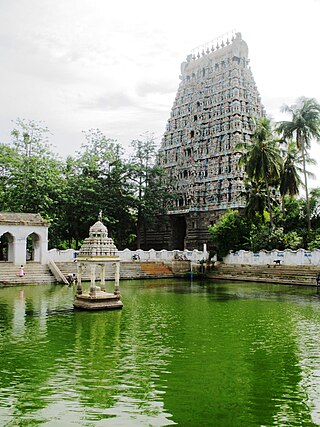
Mayiladuthurai is a Special grade Municipality and district headquarter of Mayiladuthurai district in Tamil Nadu, India. The town is located at a distance of 256 km (159 mi) from the state capital, Chennai.
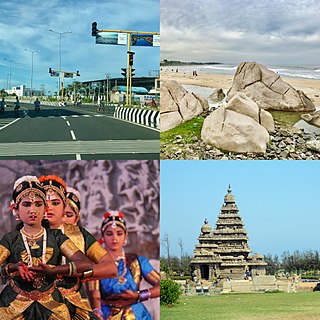
Mamallapuram, is a town in Chengalpattu district in the southeastern Indian state of Tamil Nadu, best known for the UNESCO World Heritage Site of 7th- and 8th-century Hindu Group of Monuments at Mahabalipuram. It is one of the famous tourist sites in India. The ancient name of the place is Thirukadalmallai. It is a part of Chennai Metropolitan Area. It is a satellite town of Chennai.

The Chitharal Jain Monuments and Bhagavati Temple, also known as Chitharal Malai Kovil, Chitaral Cave Temple or Bhagavati Temple, are located near Chitharal village in Kanyakumari district, Tamil Nadu, India. They consist of stone beds with inscriptions, and two monuments – one rock cut Jain temple with outer wall reliefs and one Hindu goddess temple next to it that is a combination of rock-cut and stone that was added during the reign of Vikramaditya Varaguna Pandya. The monuments are from the 9th century CE.

Papanasam is a panchayat town in Thanjavur district in the Indian state of Tamil Nadu. It is located 25 kilometres (16 mi) from Thanjavur and 15 kilometres (9.3 mi) from Kumbakonam. The name literally translates to "Destruction of Sins" in the Tamil language. It is the suburban region of Kumbakonam.
Tindivanam is a municipality in Viluppuram district in the Indian state of Tamil Nadu. It is the second largest town in Villupuram District after the headquarters town Villupuram. Important roads from north to south Tamil Nadu pass through Tindivanam and similarly from west to east.
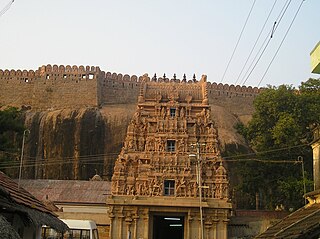
Sathyamurthi Perumal Temple in Thirumayam, a panchayat town in the South Indian state of Tamil Nadu, is dedicated to the Hindu god Vishnu. Constructed in the Dravidian style of architecture, the temple is glorified in the Nalayira Divya Prabandham, the early medieval Tamil canon of the Alvar saints from the 6th–9th centuries CE. It is one of the 108 Divya Desams dedicated to Vishnu, who is worshipped as Sathyamurthi Perumal and his consort Lakshmi as Ujeevana Thayar.
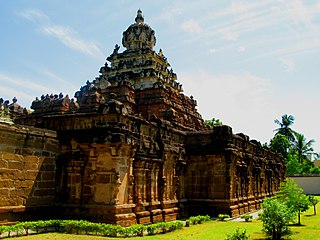
Thiru Parameswara Vinnagaram or Vaikunta Perumal Temple is a Hindu temple dedicated to the God Vishnu, located in Kanchipuram in the Southern Indian state of Tamil Nadu. Constructed in the Dravidian style of architecture, the temple is glorified in the Nalayira Divya Prabandham, the early medieval Tamil canon of the Alvar saints from the 6th through the 9th centuries CE. It is one among the 108 Divya Desams dedicated to the God Vishnu, who is worshipped as Vaikuntanathan and his consort, the Goddess Lakshmi as Sri Vaikundavalli. The temple is considered the second oldest extant temple in Kanchipuram after the Kailasanathar temple.
Tamil Nadu is the southernmost state of India located on south-eastern coast of the Indian peninsula. The state is straddled by Western Ghats and Eastern Ghats to the west and north and the waters of Bay of Bengal and Andaman Sea on the other two sides. It is the home of the Tamil people, who speak Tamil language, one of the oldest surviving languages. The capital and largest city is Chennai which is known as the "Gateway to South India". As of 2021, the state is the most visited and has received the most number of tourists amongst all states of India.

Ramachandran Nagaswamy was an Indian historian, archaeologist and epigraphist who was known for his work on temple inscriptions and art history of Tamil Nadu. He was an authority on Chola bronzes.
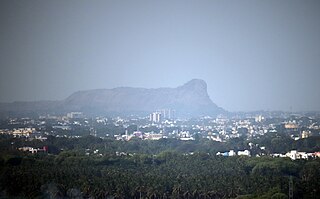
Yanaimalai is a protected monument and tourist attraction in Tamil Nadu, India. It has Jain sculptures, a Shaivite temple, and a Vaishnavite temple, namely the Narasingam Yoga Narasimha Perumal Temple.

Mangulam or Mankulam is a village in Madurai district, Tamil Nadu, India. It is located 25 kilometres (16 mi) from Madurai. The inscriptions discovered in the region are the earliest Tamil-Brahmi inscriptions.
Kovalanpottal is a place located in Palanganatham near Madakulam in Madurai district, Tamil Nadu, India. As per Tamil epic Silappatikaram, Kovalan is believed to be beheaded here by the orders of Pandyan king Neduncheziyan. It is one of the protected monuments in Tamil Nadu by the Archaeological Survey of India.
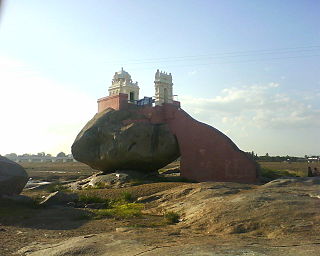
Kabilar Kundru is a hill rock in the middle of the Ponnaiyar River near Tirukoilur in Viluppuram district, Tamil Nadu, India. It is known for Tamil poet Kapilar did Vadakirrutal here, after his friend Vēl Pāri was killed in a battle. It is one of the protected monuments in Tamil Nadu by the Archaeological Survey of India.

Keezhavazhavu is a village in Madurai district of Tamil Nadu, India. It is located 43 kilometres (27 mi) from Madurai. It is known for two hillocks called Panchapandavar Malai or Panchapandavar Padukkai which contains ancient Jain sculptures and stone beds, and another is Sakkarai peer oliulla Mountain. It has a cave.
Poondi Arugar Temple is a Jain temple which located 3 kilometres (1.9 mi) from Arani, Tiruvannamalai district, Tamil Nadu, India. The temple was built by Cholas. It is one of the protected monuments in Tamil Nadu declared by Archaeological Survey of India.

Kalugumalai Jain beds in Kalugumalai, a panchayat town in Thoothukudi district in the South Indian state of Tamil Nadu, are dedicated to the Jain religious figures. Constructed in rock cut architecture, the unfinished temple is believed to have been built during the reign of Pandyan king Parantaka Nedunjadaiya. The rock-cut architecture at Kalugumalai is an exemplary specimen of Pandyan art. The other portions of Kalugumalai houses the 8th century unfinished Shiva temple, Vettuvan Koil and Kalugasalamoorthy Temple, a Murugan temple at the foothills.

Kunnakudi Shanmughanathar temple in Kundrakudi, a village in the outskirts of Karaikudi in Sivaganga district in the South Indian state of Tamil Nadu, is dedicated to the Hindu god Murugan. Constructed in the Hindu style of architecture, the temple is located in the Tirupattur - Karaikudi Road, around 14 km (14,000 m) from Karaikudi. There are three caves located on the western side of the lower rock, that has rock-cut shrines from the Pandyan Empire from the 8th century. The caves have the earliest sculptural representation of Dvarapalas, the guardian deities, for any South Indian temple.
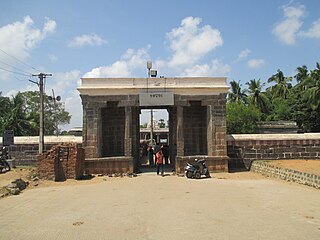
Nithyakalayana Perumal temple in Thiruvidandai, a village in Chennai, Chengalpattu district of the South Indian state of Tamil Nadu, is dedicated to Varaha, the boar avatar of the Hindu god Vishnu. Constructed in the Tamil style of architecture, the temple is glorified in the Naalayira Divya Prabandham, the early medieval Tamil canon of the Alvar saints from the 6th–9th centuries CE. It is one of the 108 Divya Desams dedicated to Vishnu, who is worshipped as Nithyakalayana Perumal (Varaha) and his consort Lakshmi as Komalavalli Thayar. The original structure of the temple was built by the Pallavas during the 7th century CE, with later additions from the Cholas during the 11th century.

This is a list of archaeological artefacts and epigraphs which have Tamil inscriptions. Of the approximately 100,000 inscriptions found by the Archaeological Survey of India in India, about 60,000 were in Tamil Nadu

Vijayamangalam Jain temple also known as Chandrapraba Tirtankarar Temple is a Jain temple in the town of Vijayamangalam in Erode district, Tamil Nadu.
References
- ↑ "Protected Monuments in Tamil Nadu". Archaeological Survey of India . Retrieved 8 April 2014.
- ↑ "Kumbabishekam planned". The Hindu . 22 May 2009. Archived from the original on 6 June 2009. Retrieved 8 April 2014.





